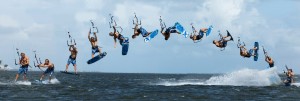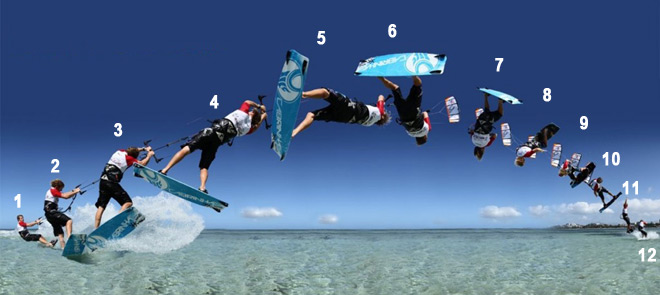KGB
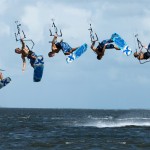
Don’t ask me where the name comes from… I can’t see any similarity between KGB and the russian intelligence, but whatever, here is the guide to perform the trick =)
- Come into the trick like you would do for an unhooked backroll. Unhook, edge hard and pop out of the water.
- Look over your front shoulder and go into a backroll rotation. When just over 1/2 way through your rotation throw your head in the other direction over your back shoulder and pull your hands hard to your front tip.
- Pass the bar from your front hand to your front hip.
- Once you grab the bar, reach around with your other hand and get them both on the bar.
- Spot your landing, bend your knees and ride away.
Tips! When unhooking always keep your elbows bent, this helps you keep a good edge. Try not to lean forward when you unhook. Keep your hands in the middle of the bar. Don’t throw the backroll to hard, it makes it hard to change direction.
Front to Blind
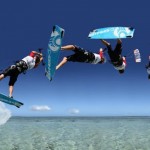
Our front loop love bubble wouldn’t be complete without adding the awe-inspiring blind landing a cheeky surface pass out. Tricks to blind looks phenomenal, feels sensational, and once you get the hang of landing blind; they will all start to be seen in your family of tricks.

THE KNOWLEDGE
You will need to get this move sorted in your head before you go and play. In theory, it is one and a half front rotation, but if you attack it like this, it will be much harder for you to land. To get the control and therefore consistency out of this move, you must consider it for what it is – a front loop, but then in preference to landing on a flat board off the wind as normal. Here are the two parts to perform this trick perfectly without you getting in a midst of nowhere.
CONTROL
No matter what move you’re attempting to blind, the key is having the move consistent so that you know how much rotation, how much speed and height you will have. If you practice your popped front enough, it will eventually feel natural to the point of the landing always being predictable. This way you’ll be able to think ahead, seemingly giving yourself time, and get yourself ready for a blind reception.
THROWING IT LATE
Landing blind in most situations is all about “throwing it late”. That’s to say you go for the twist to blind just before you land. If you try and go blind up in the air, there is a little chance of holding that position on the way down. The answer is to wait until you think it is almost too late, and then go for it. As you can see this will be difficult without having the rotation that you expect.
TWO HANDS ARE BETTER THAN ONE
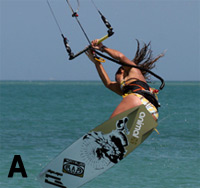 You may all want the style of some good surfers but you will have to build up to that. If you have been practicing your pop to raley to blind, you’ll notice that you are using your both hand t pull the bar in to rotate your blind. This gets the bar nearer to you, swings you towards the bar and in the front loop variant will stop you over-rotating. Admittedly doing it all one handed may look like “da bomb”, but it will be much harder, so get a grip. See pic A.
You may all want the style of some good surfers but you will have to build up to that. If you have been practicing your pop to raley to blind, you’ll notice that you are using your both hand t pull the bar in to rotate your blind. This gets the bar nearer to you, swings you towards the bar and in the front loop variant will stop you over-rotating. Admittedly doing it all one handed may look like “da bomb”, but it will be much harder, so get a grip. See pic A.
In this phase you are in the “throwing it” phase. You need to pull the bar towards you with both arms and it should be twisted already quite far around, you need to let go of your back hand followed by your body and twist all the way.
TWIST AND SHOUT
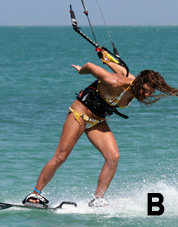 You are in the final phase now; this move is getting your body around to face the right way once you have landed. This will give you balance as it will stop you edging against the kite on your toes and it enables you to pass the bar. Like the surfer in pic B You should twist your left hand during the landing so that your thumb is pointing in the way you should go and this also will turn your shoulder more, then turn your head and look where you should go, which in turn puts your weight onto your heels and slackens the kite lines as you steer down towards the kite. It also puts the bar in place for you to reach up and grab it.
You are in the final phase now; this move is getting your body around to face the right way once you have landed. This will give you balance as it will stop you edging against the kite on your toes and it enables you to pass the bar. Like the surfer in pic B You should twist your left hand during the landing so that your thumb is pointing in the way you should go and this also will turn your shoulder more, then turn your head and look where you should go, which in turn puts your weight onto your heels and slackens the kite lines as you steer down towards the kite. It also puts the bar in place for you to reach up and grab it.
FRONT TO BLIND – ALL IN ONE!
1-3. Carv hard upwind against the kite to get enough lift and time to rotate. Position the kite at about 11 o´clock. If you put it closer to 12 you´ll lose your forward momentum and drop in the water without power. Position the kite lower around 10 o´clock and you´ll land with speed, eventually with too much speed!
4-5. Rotate and extend and turn your head to start spot your landing. Also don’t pull to much on your back hand since this will get much harder to perform the handle pass if the kite is to high.
6. Your are now in the same position as you would be in a simple front roll. Focus on where you will land and force your hands, the control bar and the rest of your body around as if you´re preparing for for a downwind land.
7. Now it´s time to throw the bar. Pull the bar towards you and twist your hip, legs and board further. Pull the back leg up towards your bottom and extend your front leg. This means that even if you land across the wind, the board will pivot under your right foot and end up further off the wind. If both legs are straight you will just hit the water and stop.
8. As you land make sure that your weight is on your right leg to allow the board to pivot further off the wind (of course your right leg will be the left leg if you rotate in the other direction as the surfer in the picture below).
9. Twist your hand and point your thumb in the direction you´re going.
10. Turn your head and shoulder even further
11. The turning will put the weight on your heels and take the tension of the lines, so you can bend over and get the bar nearer your back.
12. Pass the bar without and double-jointed contortionist skills =)
TOP TIPS
Whilst steering, try not to have too much speed, as landing a fast blind is a challenge for you.
KEYSTONES
1. Carve hard to go up.
2. Get enough height and time for the rotation.
3. Use both arms.
4. Let go of the body during the “throwing it” phase to rotate.
5. Throw it late.
6. Look where to land.
7. Control your twist after you land.
8. Twist and shout!
Some videos:
Front To Blind – Wakeboarding
Or why not add an extra front roll like Mike Blomvall and you´ll have a 720 Front To Blind
F-16
F-16
WHAT IS THIS, AN AIRFORCE JET PLANE?
No, the F-16 is a fundamental nature of an unhooked back loop kite loop, a kite loop being when the kite is hurled against the direction of travel.
Its core difference from the hooked in version, or in fact the purest unhooked version is the way that you hold the bar. As we shall see both hands will be grasping onto one side of the bar, which forces the kite to turn extremely fast. This in turn means that there is very little input from the surfer once it’s all begun, and that the kite will not produce g-suit necessitating forces. A real grin and bear it move, which is well within the reach of anyone who can back loop kite loop and unhook.
ANGLING
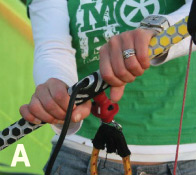 Pic A. Here we can see that the surfer is holding the bar with both hands centered in normal position riding to the right side.
Pic A. Here we can see that the surfer is holding the bar with both hands centered in normal position riding to the right side.
Now the surfer has two options, and it is up to you to see which you use. Knowing that you will need to get both hands on the back of the bar, you could either:
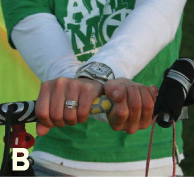 Pic B. Leave your back hand
Pic B. Leave your back hand 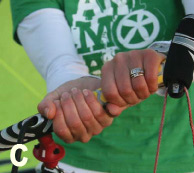 where it is, let go of your front hand and move it.
where it is, let go of your front hand and move it.
Or Pic C. move your back hand down to the end of the bar, release your front hand and grab the bar just the other side of the chicken loop in front of your back hand also with your palm facing up.
Both of these procedures work, although the first one necessitates less movement. Grab your bar and straighten your arms above your head to see which feels most comfortable.
THE KITE
The kite is very much dictating what is happening in the F-16. It will pull you up, it will rotate you and it will softly drop you back down once it finishes the loop.
It is very vital to trim your kite with the center line adjustment strap so that you are in control. Bowsexuals could leave a little more power in the kite as they do tend to turn quicker.
Doing an F-16, you will need to aim and position your kite very close to 12 o’clock above you. Like other powered techniques, starting while traveling slightly downwind will help. For the F-16, there are two grounds for this, other than the fact that it will be easier to unhook.
Firstly, once you have unhooked, if the lines are not completely tight, the kite will not move swiftly as you change your hands. This is very important especially on small kites.
Secondly, you need to do the whole rotation in the air. Most of us are used to doing the first half of a back loop by carving big time into the wind, which means that we’re already turned 180 degrees before taking off. If we do this for the F-16, we will overdo the spinning process. By cruising slightly off downwind, it allows us to carve for pop without turning too much into the spin.
THE YOU
The other main ingredient to a successful F-16 is an early take off. If you wait until the kite pulls you off the water, it will already have turned too far, and therefore pull you around too early, making landing a little wobbly or leading to a bad case of over rotation.
The best thing to do is to physically jump up into your back loop off your edge just before you think the kite will pull. By doing this, you’ll aim to finish half the spin. If you can look upwind while being at the peak of your jump, the kite will take over and bring you around for a nice soft landing. However, this may take a bit of practice to get the timing.
REAL TIME
The approach for the following sequence is identical to that of the down loop s-bend. Having had a very good look around to check that the coast is clear and that you have provided yourself miles of space downwind, slowly hurl the kite up towards 12 o’clock, flatten the board off to bear off the wind slightly and unhook. As soon as you have unhooked change your hands.
1. Once the hands have moved, it’s time to get back on your edge so that you’d still have some power to pop off. Do this by dropping your weight low and getting your shoulders out and upwind of the board. The bar is now vertical, this will happen automatically.
2. Just before the kite pulls, carve hard bending the rear leg ready to pop upwards. Your head should be looking forward in an effort not to create too much rotation.
3. Pop off; jump up across the air powerfully. Keep your head equally close to your shoulders. Your aim is to do half a back loop.
4. The kite has now travelled far enough behind that it pulls up.
5. As the kite starts looping, the power will extend you. The turning of the kite should pull you around.
6. When you feel the power collapse, look over your shoulder and locate a landing spot.
7-9. Remain focused on where you expect to land. The kite will have little power, and as a result, you will drop back towards the water surface. Grab and pull the bar in towards your hips to get your legs back underneath you.
10. With your legs dropping underneath, try and focus on pointing the board downwind.
11. On landing, try and maintain your weight over the back of the board.
12. Review where the kite is. If it is not travelling forward, let it continue to loop until it is, then release you upward facing palm (original front hand), place it back on the front of the bar and then hook in.
BEST TIPS
A speedy approach will make the pull from the kite seem far less violent while it gives you more control and a smoother landing.
If the bar is getting ripped out of your hands, try not to edge too hard for too long. Go downwind a bit more.
Try to imagine the F-16 as a game of follow the leader. As the kite loops you, just follow it around one step behind.
Dropping the back hand as you come down can help slow down the spin and also makes a speedy landing a whole lot easier.
If you keep on over rotating without getting any height, try not to throw a back loop, but ease into it by jumping up.
The more power you have in the kite, the higher and harder you will go. Just take it easy when learning.
This is how it should look after some practise 🙂
